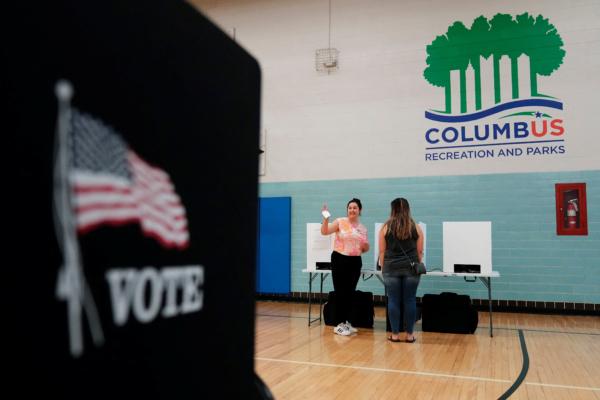Abortion is a hot-button topic nationwide, and in Ohio, a proposed amendment that would establish an “individual right to one’s own reproductive medical treatment including but not limited to abortion” has generated tension from people on both sides as the issue will be decided on Nov. 7.
Ohio’s Issue 1, the “Right to Make Reproductive Decisions Including Abortion Initiative,” will add abortion rights to the state constitution if approved.
The proposed measure would also establish a state constitutional right to make decisions about “contraception, fertility treatment, miscarriage care, and continuing pregnancy,” according to Ballotpedia.
“The amendment does say that while abortion may be prohibited after fetal viability—which it defines as what a doctor decides on a case-by-case basis based on significant likelihood that the baby would survive.
“Abortion must be allowed under Issue 1 if the doctor thinks that the abortion would be necessary for the patient’s health.
“Health is not defined as physical health. Instead, it’s just health, which courts including in Doe v. Bolton have already said is a sweeping term that includes all factors relevant to the well-being of the mother, and that includes family size.
“So that in essence puts no restrictions on late-term abortions,” Ms. Mailman added.

On Aug. 8, Ohioans overwhelmingly defeated a proposed amendment to the state constitution that would require 60 percent support from voters to change the constitution compared to the current 50 percent plus one model.
Issue 1 generated nationwide interest and advertising spending because of its impact on the current Issue 1 which will determine if abortion is enshrined in the state constitution.
The Ohioans for Reproductive Freedom—a pro-abortion coalition that includes Planned Parenthood, Pro-Choice Ohio, the Abortion Fund of Ohio, the American Civil Liberties Union (ACLU) of Ohio, and the Ohio Physicians for Reproductive Rights—introduced “The Right to Reproductive Freedom with Protections for Health and Safety,” which would add a Section 22 to Article 1 of the state Constitution.
This would remove Ohio’s parental notification legislation when a minor wants an abortion and would permit abortion to the point when a fetus can survive outside of the womb.
In 2019, the Ohio state legislature passed a “heartbeat” bill that bans abortion around the six-week mark. That went into effect after the Supreme Court’s Dobbs v. Jackson ruling. Almost immediately, the law was challenged and remains tied up in court.
The law does not include exceptions for rape or incest victims and was paused by a court.
Its fate will be determined by the Ohio State Supreme Court.
It’s easier to change a state law than it is to amend the state constitution, Gov. Mike DeWine said.
“If we can defeat this amendment, which I certainly hope we can, it will give us the opportunity in Ohio to try to come up with something that the majority of Ohioans can support,” Mr. DeWine said, noting that a new bill should include exceptions for rape and incest.
Similar battles are being fought across the nation as state legislatures pass abortion restriction measures that have yet to take effect. Ohio is being closely watched since it is the only state this fall to vote on the issue.
Baldwin-Wallace University in Ohio released an October poll that indicated Issue 1 will pass by a similar margin to the one that was defeated in August.
According to the survey, 58 percent of likely voters said they were certain to support the measure while 34 percent said they would vote “no.”
Pro-life advocates believe the amendment is too broad and will compromise parental rights.
Mr. DeWine, a Republican, has called the proposed amendment “too extreme” for Ohio.
The Ohio Right to Life’s website states that the proposed amendment is “particularly dangerous because of the intentionally broad and vague language in it.”
The broad language will result in the “dismantling of parental rights and all common sense abortion regulation,” according to the website.
Abortion rights advocates claim that Republicans will try to ban all abortions, like in neighboring Indiana.
“I have no doubt they will go forward with [a total ban] because that’s always been their agenda,” said Kellie Copeland, executive director of Pro-Choice Ohio. “That’s really what’s at stake with Issue 1.”
Abortion rights groups have substantially outraised and outspent pro-life organizations leading to Nov. 7.
Campaign finance reports show that Ohioans United for Reproductive Rights, which is the main coalition backing Issue 1, has generated $28.7 million compared to $9.9 million raised by Protect Women Ohio, the group that is most vocal against the measure.
Ohio’s anti-abortion coalition has received more than $15 million from Susan B. Anthony Pro-Life America for both the August and November Issue 1 initiatives, campaign finance records show.
Sixteen Thirty Fund, a progressive secret money organization, has contributed $5.5 million. Open Society Policy Center, which is affiliated with left-leaning billionaire George Soros, has donated $3.5 million.
AdImpact reports that, since Labor Day, Democrat groups supporting Issue 1 have poured more than $20 million into ads compared to $8.5 million spent by groups that oppose Issue 1.
In communities across Ohio, signs in favor of and against Issue 1 are visible in yards and along busy streets.
Joe Overholser is running for city council in Kettering, a suburb of Dayton in southwest Ohio. He is also an opponent of Issue 1 and had two signs uprooted from his lawn.
“My wife saw him steal the signs. He was jogging on our street, stopped and grabbed the signs, and kept jogging,” Mr. Overholser said.
Mr. Overholser’s wife called him and told him the direction the jogger headed. He caught up with the culprit and captured an exchange on cell phone video.
According to the video, Mr. Overholser told the man that he had taken his signs.
The man responded by looking at Mr. Overholser, tearing up the signs, dropping them to the ground, and telling him to call the police.
Mr. Overholser obliged and filed a report in person, emailing the video.
The Kettering Police Department posted the video on Facebook, asking citizens to identify the man.
When the jogger’s identity was confirmed, he was arrested, arraigned, and charged with misdemeanor theft and criminal damage.
He pleaded not guilty and is awaiting trial.
The incident further illustrated how contentious Issue 1 is in Ohio.
“I think he needs to be punished and an example needs to be set to prevent people from stealing campaign signs,” Mr. Overholser said.
“There was widespread theft of signs back in the August special election, and there was for the current issue—until news spread about this man doing what he did.”
“People on both sides of the issue are passionate, but stealing is wrong and against the law,” Mr. Overholser added.
“We live in a mostly free country and mostly free speech and displaying campaign signs is one way we utilize our freedom of speech. Taking campaign signs is not only theft, but it is also attempting to take away someone’s right of free speech.
“It is similar to censorship on social media.”
Wes Farno, a Republican campaign strategist in Ohio, told The Epoch Times that, for Issue 1 to be defeated on Nov. 7, churches would have to be vocal about their opposition.
Leaders of churches have been outspoken, but not all would like to see Issue 1 defeated.
Reverend Tim Ahrens is a senior minister at First Congregational Church, United Church of Christ in Columbus, He wrote an opinion piece in The Columbus Dispatch offering his support of Issue 1.
“Since early October, I have had the unique position of being the only Ohio religious leader in an ad running statewide on TV and radio in support of adding a constitutional amendment to the Ohio Constitution protecting women’s reproductive rights. I believe in access to safe, affordable, and legal abortions,” Mr. Ahrens wrote.
“I believe the government should not be in the business of making decisions about reproductive rights for any of us. No matter what your gender, I believe every person I encounter, including myself, has the right and responsibility to care for their own body,” Mr. Ahrens explained.
The minister added that opposition to his stance has emerged from “’Christians’ who have taken it upon themselves to be judge and jury over my eternal soul.
“The people opposing Issue 1 have shown me their true colors—hate in the name of Jesus.”
Gary Click is a Republican state representative in Ohio and a pastor. He is a staunch advocate against Issue 1, claiming that it “is worse than Roe.”
“Under Roe, reasonable safeguards such as parental consent or pain-capable protections could be established. Even those who support abortion under certain conditions realize the vital role of parents in such critical times.
“Some will respond, ‘Well, what if the father is responsible?’
“It’s obvious that they haven’t thought this through. No father that has committed such a heinous criminal act would want to protect the evidence. He is more likely to insist on an abortion. However, under Issue 1, he is protected.
“Questioning the perpetrator who brings in a victim would be considered an undue burden under Issue 1. Do we really want to protect pedophiles? Who can support that? “ Mr. Click wrote in a statement.
Issue 1 also “grants the right for reasonable regulation at the point of viability, or when the child can survive outside of its mother’s womb,” Mr. Click explained.
“While the language does indeed say that abortion can be regulated at the point of viability, it then grants exceptions to the abortionist at his own discretion.
“The exceptions are loosely defined as the ‘health’ of the mother. While it is reasonable to protect the mother’s life, the word health is so loosely defined that it can mean anything the abortionist wants it to mean,” Mr. Click wrote.
“When the abortionist defines the terms, you can’t pretend that there is an expectation of reasonable regulation. It will be legal all the way up to birth, including partial-birth abortion. That is insane in any culture,” he added.
“This is not Roe reinvented. This is worse than Roe. Much worse. Issue 1 will embed this dark reality in Ohio’s Constitution where it will be virtually impossible to revise, remove, or repair.”
Jessica Franz was a Bethel school board member in western Ohio until she stepped down last year after being elected to the state central committee.
She is an Issue 1 opponent and believes that churches should be vocal about any ballot measure regarding abortion and children.
Over the last two months, she estimates she has visited more than 50 churches, talking to pastors and leaving literature explaining Issue 1 on cars in church parking lots.
“Churches have to speak up, otherwise there is no chance of defeating Issue 1. We are being outspent in the state and from groups across the country, so it’s important that pastors educate their congregations about what will happen if Issue 1 passes, tell the congregation how they are voting, and why,” Ms. Franz told The Epoch Times.
“I was reluctant to talk to pastors and leave the literature on cars at first because I knew I would hit some walls, and face some opposition,” she added. “But this a moral issue, and it’s absolutely something the church should be speaking to.”
 NewspaperUS A User-friendly News page for the Modern World
NewspaperUS A User-friendly News page for the Modern World






